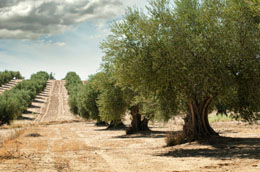The healthy olives come from the olive tree, this we all know, but only appropriate care will ensure a steady and good quality harvest. This article guides you with the basic steps that should be followed to ensure that the olive tree is being taken care of.

Native to the coastal areas of the eastern Mediterranean Basin, the olive is a species of the
Oleaceae family. The fruit is known as olive and is as important as the oil extracted from it in most Mediterranean diet. The tree grows only in an agreeable climate which is characterized by a long and hot growing season, which is a major consideration and requirement for planting olive trees.
It is an evergreen tree that does not grow more than 50 feet in height and 30 feet in width. The foliage is feather-shaped, arranged opposite to one another, with a gray-green appearance because of the presence of tannin. The tree does not shed leaves every year, with new growth occurring simultaneously in the spring every couple of years. The flowers are cream-colored and mostly wind-pollinated. The fruit is a green drupe, and upon maturity, can turn blackish-purple or brownish-purple depending upon the variety.
For an olive tree to grow and fruit, it needs a long, hot growing season, else the fruit won't ripen. No late spring frosts or extreme winter chills. This is the reason most olive cultivation and production in America is concentrated in the warmer coastal valleys of California.
This tree also comes in non-fruiting varieties that are specifically meant for landscaping. It has an attractive gnarled branching pattern, that gives it an unusual appearance. Olive trees need well-drained soils with a pH of 8.5, and a sunny spot. Avoid planting them in the path of the wind.
Transplanting needs to be done carefully. The tree should be planted together with the root ball, ensuring no damage to its roots has been done, especially when pressing it down to firm the plant. Experts recommend that after planting, the surrounding soil should be covered with straw to minimize water loss from the soil. Young trees are more prone to dying out because of improper irrigation, hence water regularly during the first 2-3 years. For more number of trees, a drip irrigation system is recommended. Olive trees should be fed with nitrogen rich fertilizer annually, well ahead of the flowering development time. Organic compost is equally beneficial.
Pruning is essential to control the plant's growth, maintain its shape, and increase the yield. Most tree heights can be controlled at 20-25 feet, for easier access to yield. Pruning is done to develop the tree along a central leader style and develop a strong structure. Old branches are cleared before the setting of flowers and fruit to increase yield, and the last prune is done after fruiting to get rid of old, weak, and diseased branches.
The main pest problem suffered by olive trees involves the olive fruit fly and medfly. Olive knot is another problem which can be controlled with pruning. Fungal disease verticillium is another problem with olive tree, and the only cure is to get rid of the infested branches. As olive is eaten with the skin intact and used in oil extraction, too many pesticides should be avoided. Indoor care of olive trees involves exposing them to well-lit ares, fertilization, and a good measure of irrigation.
With adequate olive tree care the olives will grow nice and healthy. Pick your olives, green, but only after they have reached full size.






 Native to the coastal areas of the eastern Mediterranean Basin, the olive is a species of the Oleaceae family. The fruit is known as olive and is as important as the oil extracted from it in most Mediterranean diet. The tree grows only in an agreeable climate which is characterized by a long and hot growing season, which is a major consideration and requirement for planting olive trees.
Native to the coastal areas of the eastern Mediterranean Basin, the olive is a species of the Oleaceae family. The fruit is known as olive and is as important as the oil extracted from it in most Mediterranean diet. The tree grows only in an agreeable climate which is characterized by a long and hot growing season, which is a major consideration and requirement for planting olive trees.